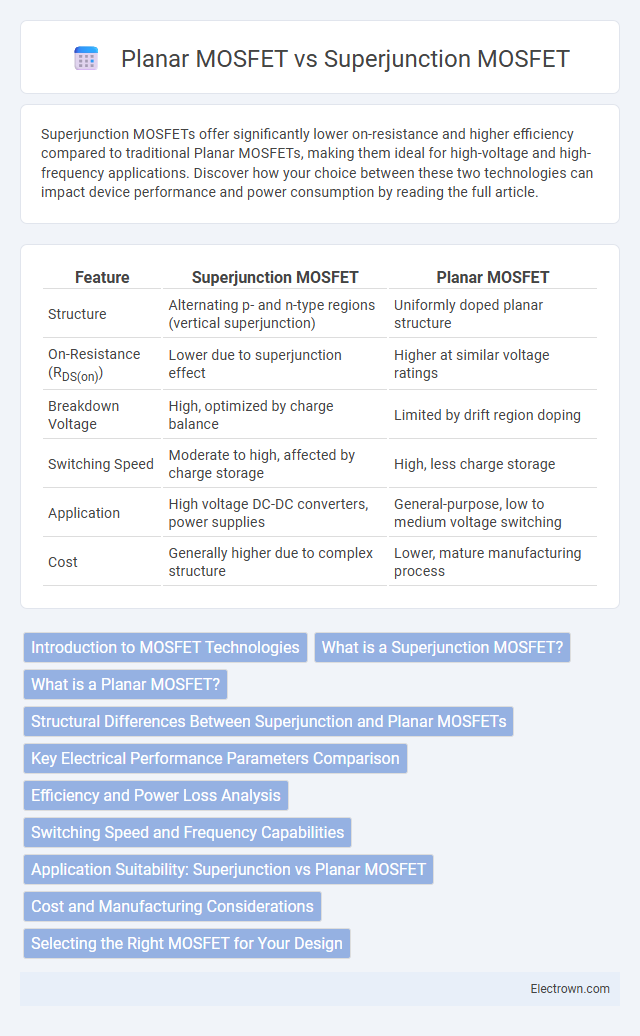Superjunction MOSFETs offer significantly lower on-resistance and higher efficiency compared to traditional Planar MOSFETs, making them ideal for high-voltage and high-frequency applications. Discover how your choice between these two technologies can impact device performance and power consumption by reading the full article.
Table of Comparison
| Feature | Superjunction MOSFET | Planar MOSFET |
|---|---|---|
| Structure | Alternating p- and n-type regions (vertical superjunction) | Uniformly doped planar structure |
| On-Resistance (RDS(on)) | Lower due to superjunction effect | Higher at similar voltage ratings |
| Breakdown Voltage | High, optimized by charge balance | Limited by drift region doping |
| Switching Speed | Moderate to high, affected by charge storage | High, less charge storage |
| Application | High voltage DC-DC converters, power supplies | General-purpose, low to medium voltage switching |
| Cost | Generally higher due to complex structure | Lower, mature manufacturing process |
Introduction to MOSFET Technologies
Superjunction MOSFETs utilize a multi-layered structure with alternating p-type and n-type regions, significantly reducing on-resistance and enabling higher efficiency in high-voltage applications compared to traditional planar MOSFETs. Planar MOSFETs feature a single, flat channel structure, which limits their scalability at higher voltages due to increased conduction losses and lower efficiency. The advanced charge balance design in superjunction MOSFETs optimizes the trade-off between breakdown voltage and conduction resistance, making them ideal for power conversion and switching applications.
What is a Superjunction MOSFET?
A Superjunction MOSFET is a type of power transistor designed with alternating p-type and n-type regions in the drift area, enabling significantly reduced on-resistance and improved efficiency compared to conventional Planar MOSFETs. This advanced structure allows for higher voltage blocking capability while minimizing conduction losses, making it ideal for high-performance power conversion applications. Understanding the benefits of a Superjunction MOSFET can help you optimize your designs for enhanced power density and lower energy consumption.
What is a Planar MOSFET?
A Planar MOSFET is a traditional metal-oxide-semiconductor field-effect transistor characterized by its flat, horizontal channel structure where current flows parallel to the substrate surface. It features a gate, source, and drain arranged on a single plane, with conduction occurring through a uniformly doped silicon region beneath the gate oxide. Planar MOSFETs are widely used in low to medium voltage applications due to their simpler fabrication process and well-established technology.
Structural Differences Between Superjunction and Planar MOSFETs
Superjunction MOSFETs feature alternating p-type and n-type pillars within the drift region, which significantly reduces on-resistance while maintaining high breakdown voltage. In contrast, planar MOSFETs have a uniform, single-type drift region leading to higher resistance and lower efficiency under high voltage conditions. Your choice of device structure directly affects power conversion efficiency and thermal performance in high-voltage applications.
Key Electrical Performance Parameters Comparison
Superjunction MOSFETs exhibit significantly lower on-resistance (R_DS(on)) and improved breakdown voltage, enabling higher efficiency in power conversion compared to Planar MOSFETs. The charge balance principle in Superjunction devices reduces conduction losses and enhances switching speed, resulting in better performance for high-voltage applications. In contrast, Planar MOSFETs typically show higher capacitance and switching losses due to their simpler doping structure.
Efficiency and Power Loss Analysis
Superjunction MOSFETs significantly reduce conduction and switching losses compared to Planar MOSFETs by utilizing a vertical structure with alternating p-type and n-type columns, enhancing charge balance and lowering on-resistance. This architecture results in improved efficiency, especially in high-voltage applications where power loss directly impacts thermal management and system performance. Optimizing your design with Superjunction MOSFETs can lead to lower energy dissipation and higher overall efficiency in power conversion systems.
Switching Speed and Frequency Capabilities
Superjunction MOSFETs offer significantly faster switching speeds and higher frequency capabilities compared to Planar MOSFETs due to their reduced on-resistance and lower gate charge. You benefit from improved efficiency in high-frequency applications such as power supplies and motor drives, where rapid switching is critical. Planar MOSFETs, while reliable, typically suffer from higher switching losses and slower transitions, limiting their performance in high-frequency scenarios.
Application Suitability: Superjunction vs Planar MOSFET
Superjunction MOSFETs offer superior efficiency and higher voltage handling, making them ideal for high-power applications such as electric vehicles, power supplies, and industrial motor drives. Planar MOSFETs, with their simpler structure and lower cost, suit low-voltage, low-power applications like consumer electronics and small signal processing. Your choice depends on balancing performance needs against cost and application-specific voltage requirements.
Cost and Manufacturing Considerations
Superjunction MOSFETs typically involve higher manufacturing complexity due to their intricate charge balance structure, leading to increased production costs compared to planar MOSFETs. Planar MOSFETs benefit from mature, well-established fabrication processes, resulting in lower manufacturing expenses and better cost-efficiency for high-volume applications. Your choice depends on balancing cost with performance requirements, as superjunction devices offer superior efficiency at a premium price point.
Selecting the Right MOSFET for Your Design
Superjunction MOSFETs offer lower on-resistance and higher efficiency compared to Planar MOSFETs, making them ideal for high-voltage and high-frequency applications. Planar MOSFETs excel in cost-sensitive designs with moderate voltage requirements due to their simpler structure and manufacturing process. Your selection should consider trade-offs between performance, cost, and thermal management to optimize overall circuit efficiency and reliability.
Superjunction MOSFET vs Planar MOSFET Infographic

 electrown.com
electrown.com